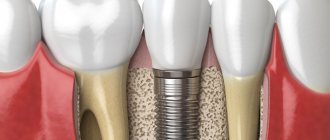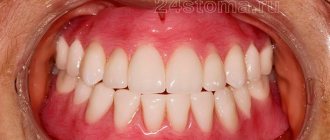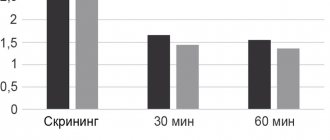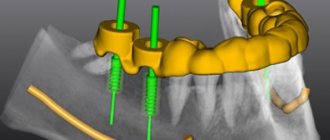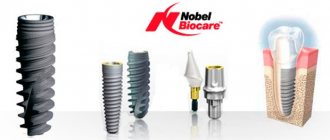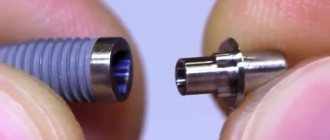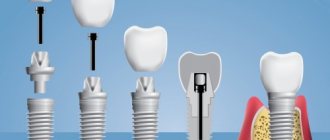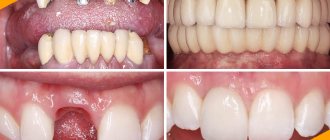In the photo: implants, made in Sweden
Until recently, there were a relatively small number of implantation systems on the Russian market. Basically, these were systems from leading foreign world brands, quite expensive, and the dental implantation service itself belonged to the premium class dentistry segment.
Along with foreign implantation systems, there were (and still are) implants from domestic manufacturers. Russian-made implants were often made of less pure titanium, and their design was far from perfect, as a result of which the success rate of implantation was quite low. It is these implants that have given rise to so many fears and myths about their rejection.
Is implantation an expensive procedure?
The cost of dental implantation depends on the following factors:
- Category of dentistry. In large clinics with a large number of patients, competition remains, and therefore services can be provided at more affordable prices compared to small centers.
- Doctor's professionalism. Training in advanced training courses and specialized seminars costs a lot, so the services of an experienced person are not cheap. The cost of treatment is also related to whether the clinic has all the permits. Receiving and updating them entails monetary costs.
- Method of implantation used: traditional 2-stage;
- express technology;
- basal;
- mini-implantation;
- laser
In addition to the implant itself and the superstructure, it is necessary to pay for diagnostics, multiple surgical interventions and various consumables.
What to do to avoid unexpected expenses after tempting offers:
- Always compare prices and research the market before agreeing to implant surgery. You don’t have to go to clinics for this – the Internet can help you.
- Do not hesitate to request certificates of conformity for the proposed implant and registration certificates with an individual number. This is a guarantee that the implant is truly high quality.
- Ask the clinic staff to draw up an estimate that states how much you need to pay for each stage of implantation, and what the final amount will be. The price may fluctuate, but no more than 10%.
Attention! Use the services of those dental clinics that do not require advance payments. Everything must be paid upon completion of the work. The dental implant procedure is no exception.
What is the reason for the high cost of dental implants?
Today there are over 300 companies offering dental implants on the market. Materials, research labor, and manufacturing involve significant costs, so implants simply cannot be cheap. When producing implant systems, the following main characteristics are taken into account:
- Material. In most cases, the production of artificial roots is made from titanium alloy Ti-6Al-4V, which contains some vanadium and aluminum. These components make the material more durable, but reduce the rate of fusion of the implant with the jaw bone. In the manufacture of premium implants, pure titanium G4Ti is used, which contains no additional elements. In addition, materials for manufacturing can be an alloy of titanium and zirconium dioxide, as well as metal-free ceramics. Ceramic products are an excellent alternative to metal rods for patients with mucous membrane problems or allergies to metal.
- Surface features. The rate of osseointegration of the implant depends on the type of surface. During the initial surface treatment, the product is turned with alumina or titanium oxide and etched with acid. We are talking about the so-called SLA technique, the use of which makes the surface porous and rough. After this stage, special chemical compounds (fluoride ions, calcium phosphate and phosphorus) are applied to the surface to reduce the duration of bone tissue synthesis.
- Thread options and implant shape. The interaction of a particular implant model with the jawbone depends on many factors. There are several types of bone - D1, D2, D3 and D4. D1 is considered the densest, and D4 is considered the softest. High density bone guarantees high primary stability, but osseointegration in this case takes a long time due to the minimal number of blood vessels. The softest bone is not the best option for installing an implant. The most suitable bones are types D2, D3.
The presence of dense bone indicates the need for conical and cylindrical implants. Excessively coarse threads should not be used, as this will create increased stress, which can provoke atrophy. It is desirable that there be a microthread in the area of the rod neck, and a moderately pronounced thread at the bottom of the element. When working with soft bones, conical products with self-tapping threads are used.
The choice of dental system is carried out taking into account the size of the alveolar process of the jaw and its density. You also need to take into account the area of implantation and the method of prosthetics.
Guarantee of high-quality implantation
By giving such an amount, the patient hopes for a quality result. To get a strong implant that will last for many years, evaluate how carefully the clinic prepares for manipulation. If at least one of the steps mentioned above is not included in your treatment, this is a reason to think about it. There are cases when implants do not take root at all. In the entire world practice there are only 3% of them, but they still exist. According to experts, a good result during implantation depends on both the patient and the doctor.
Clinic "Astrea"
Address : Krasnoyarsk st. Molokova, 1, building 4, tel. Address : Krasnoyarsk, st. Lado Ketskhoveli, 71 Tel. Website : astreja.ru Mail
“You need to take care of the implant even more than you take care of your teeth. If the patient does not pay due attention, he can quickly lose a new tooth. And if all the rules of oral hygiene are followed, regular checks are carried out by the dentist, and professional teeth cleaning is carried out every six months, then the implant can last a very long time. The patient is also obliged to follow the recommendations issued immediately after installation - take absolutely all prescribed medications, do not drink strong alcohol, avoid the sauna, swimming pool, and so on,” says Artur Avetisyan.
Pay attention to the implants the clinic works with. Choose systems that have been on the market for at least 10-15 years. Such companies invest in research, constantly improve implantation systems, and guarantee high quality. These are European companies Straumann (Switzerland), Nobel (Germany). According to Arthur Avetisyan, if we draw an analogy with the car market, then the products of these companies can be compared with Mercedes.
Differences between budget and expensive implants
Conventionally, all dental structures belong to three main groups:
- Premium systems from well-known manufacturers. Such companies invest a lot of money in research, experiments, new developments, and not just in the manufacture of suprastructures and rods. They develop training programs for doctors and constantly modernize production methods. All this affects the cost of finished products and this is not surprising. This group includes products from Astra Tech (Sweden), Nobel Biocare and Straumann (Switzerland), as well as XiVe Friadent (Germany).
- Middle price segment. This category contains manufacturers who do not develop this industry, but only copy the methods of companies from the premium segment. Some samples are not the best, since it is not always possible to completely copy the original. However, there are products that, if installed correctly, can be used for a very long time. Here we can mention the products of MIS and Alpha Bio (Israel), Ankylos (Germany) and Bicon (USA).
- Products with limited functionality. Systems in this group are produced by small budget companies. We are talking about Russian, Ukrainian and Belarusian manufacturers of dental structures.
Total implantation for complete tooth loss - what is it?
Total (complete) prosthetics involves the restoration of all teeth using fixed or (temporary) removable structures: implants and beam systems, etc. The goal of implantation and prosthetics is to return the dentition to its natural functionality and aesthetics.
Total implantation is not always done from scratch, in the absence of teeth. Sometimes patients come to us with a request to treat or replace one or two teeth. But examination under a microscope and detailed diagnostics show that the problem is much more global than it seems, and such measures will not bring benefit or even temporary relief: leveling the height of the bite or even removing teeth with subsequent implantation is required.
Aesthetic and functional prosthetics
Specialists:
Nazaryan David Nazaretovich Kyalov Grigory Georgievich
Description:
More than 10 years ago, a patient came to us for aesthetic and functional prosthetics.
16 implants were installed, after three months 28 crowns were fixed on the implants.
Specialists:
Nazaryan David Nazaretovich Kyalov Grigory Georgievich
Description:
More than 10 years ago, a patient came to us for aesthetic and functional prosthetics.
16 implants were installed, after three months 28 crowns were fixed on the implants.
What affects the final cost?
The final cost of implantation is determined taking into account the costs at different stages of work:
- Preparation - consultations with experts, obtaining tests and sanitation of the oral cavity.
- Diagnostics: performing an orthopantomogram, CT scan.
- In case of insufficient bone tissue volume, sinus lifting, directed regeneration or bone block grafting is performed.
- Surgical intervention. The specialist prepares the bone bed, installs the implant and places sutures on the mucosa.
- Installation of a gum former (after a few months). The specialist cuts the mucous membrane, dismantles the temporary element and installs the former.
- After the formation of the cushion from the gum tissue (after 14-21 days), the doctor removes the former and installs an abutment in its place.
- Prosthetics - a specialist takes impressions of each jaw, which are necessary for the manufacture of artificial crowns.
- Trying on the structure in the oral cavity, followed by correction and final fixation.
- Recovery period. The patient periodically visits the doctor to check the functionality of the implant and monitor the condition of the tissues.
Research and development
Any invention, even the smallest and most insignificant, entails a huge amount of work and millions of investments. And dental implants are no exception. It took more than one year of research, hundreds of millions of euros were spent before scientists found a bioinert material compatible with human bone tissue.
The first person to install dental implants was Per-Ingvar Brånemark, a scientist from Sweden. In 1965, his patient was Göst Larsson, who had completely missing teeth in his lower jaw. Dr. Brånemark implanted 4 implants on which a denture was then installed, which subsequently radically changed the patient’s life.
Possible savings during treatment
The experience of the dentist and the quality of the materials used are directly related to prices at the chosen medical institution. You can save money in the following ways:
- Registration of an insurance policy. Some clinics offer special discounts to people whose treatment is covered by health insurance programs.
- Simultaneous installation of dentures on several teeth. Thanks to this, you will not have to spend extra money on painkillers, impressions and x-rays.
- Refusal to install a temporary crown when installing an implant in the chewing area.
Three-dimensional computer modeling of templates for total prosthetics
To determine the most organic arrangement of teeth, NKclinic specialists use virtual programs, building future dentition in 3D. The three-dimensional model takes into account the condition and thickness of the bone tissue, allows the implant surgeon to perform a virtual operation and immediately assess the future result. Thus, a “controlled implantation” operation, planned in advance to the smallest detail, when prostheses are installed in a precise manner at certain positions, gives a 100% predictable result.
3D modeling also helps us to pre-fabricate future temporary orthopedic structures, respecting all individual parameters. Therefore, after the process of implantation and prosthetics, the patient immediately receives temporary crowns supported by implants, which reduces the “toothless” period to zero and allows a quick return to normal life.
Refund of part of the money spent on prosthetics
In March 2001, the Government of the Russian Federation issued Decree No. 201, which approved a list of costly types of treatment. One of the points on this list states that dental implantation is an expensive type of treatment. When drawing up a document on payment for medical services, which will be submitted to the tax office, the dentist indicates a code that classifies the treatment as cheap, and “2” as expensive. For implantation, code “2” is used. However, the list does not mention prosthetics on implants.
Why patients pay more when they fall for the “bait” of a low price
When you contact dentistry for a promotion that promises to install an implant at a low price, you will most likely:
- They will offer cheap implants, passing them off as premium.
- They will quote an inflated price for the crown by 2-4 times, due to this the price of the implant will be reduced by 2-4 times.
- They will set conditions. that you immediately need to order a crown while there is a campaign for installing “cheap” implants.
- They will rush the decision, arguing that you could miss out on a very profitable offer,
- Offer instant loan processing if there is not enough money for a crown.
As a result, the patient pays 4-5 times more than planned and at the same time feels guilty towards himself and his loved ones for unforeseen expenses.
In fact, he is not to blame for absolutely anything. Objective information is deliberately hidden from the patient so that he does not understand that he needs to pay several times more than the price promised in the advertisement.
Tax deduction - in what cases and how much money can be returned
The tax deduction provides taxpayer patients with the opportunity to receive compensation in the amount of 13% of the cost of treatment. This possibility is provided by two documents:
- Article No. 219 of the Russian Tax Code, according to which all taxpayers have the right to receive an annual 13 percent compensation of the amount that was spent on treatment in various domestic medical institutions.
- Decree of the Russian Government No. 201 of March 19, 2001, which specifies the process for obtaining a tax deduction and a list of specific medical services, the cost of which can be compensated.
A percentage of the funds spent is accrued for the following types of services:
- medical procedures that were provided to the taxpayer or his spouse, minor children, parents;
- paid insurance premiums in accordance with the health insurance agreement;
- medications that were prescribed by the treating specialist.
The determination of the tax deduction is based on the total amount of expenses and cannot be more than 120 thousand rubles throughout the year. If a taxpayer intends to receive compensation for paying for the treatment of immediate relatives, he can only count on 50 thousand rubles.
Advantages of one-stage implantation
- the waiting time usually spent on bone tissue formation and socket healing after tooth extraction is reduced;
- minimization of intervention - no incision is required to gain access to the bone, no re-incision is required after engraftment (as is the case with two-stage implantation), which means the volume of medications taken by the patient is reduced and less local anesthetics are required;
- a relatively easier rehabilitation period, less severe symptoms after the intervention;
- easy to predict the conditions and structures of soft tissues, post-implantation structure, alveolar ridge atrophy;
- aesthetics - the temporary prosthesis looks natural, which is especially important when restoring teeth in the smile area;
- saving time - fewer visits to the doctor, the ability to perform all manipulations in one appointment;
- does not require prior bone grafting;
- allows you to preserve the natural contour of the gums, eliminating the need for soft tissue plastic surgery, as in cases where a tooth has been missing for a long time;
- adaptation to the crown (temporary) occurs immediately after the intervention;
- long service life of implants and a high degree of survival if all conditions are met.
- the price of one-stage dental implantation is comparatively lower. However, this method of restoration is not available to everyone - in order for the intervention to be successful, it is necessary that the condition of the dental system meet certain requirements.
Collection and provision of documents
List of documents that need to be collected:
- an application addressed to the head of the relevant tax authority to receive a tax deduction;
- a certificate of the appropriate sample indicating the code of the medical service from the institution where the treatment was performed;
- an application to transfer money to the applicant’s personal bank account;
- a copy of the medical institution’s license to provide certain services;
- a copy of the agreement between the taxpayer or his relative with a medical institution, which contains a detailed list and cost of all services provided;
- cash receipt, which is proof of payment for services;
- a copy of the tax registration document;
- certificate 2 personal income tax from the place of work;
- copy of the passport;
- declaration of the Z-NDFL format;
- if the patient is one of the applicant’s family members, it is necessary to provide a copy of the marriage or birth certificate of the child to confirm the presence of family ties.
The entire set of documents is submitted to the tax authority in accordance with the taxpayer’s place of registration.
Place an implant on a chewing tooth: features and advantages
If you need to restore a chewing tooth, you will most likely be recommended to get an implant. Why? The answer is simple - because implantation will provide the opportunity to obtain the most reliable and durable result of the restoration of a chewing tooth and, in addition, it will not require preliminary grinding of neighboring, healthy teeth.
IMPORTANT: In classical prosthetics, before installing a prosthesis or crown, a procedure is carried out to grind the teeth that act as a support for strong fixation of the orthopedic structure. This procedure cannot be called useful in any way, since it weakens the teeth, making them more vulnerable to the action of bacteria and negative external factors. Implantation does not require grinding of teeth.
Restoring chewing teeth with implantation provides the following advantages:
- The correct bite is maintained and the functionality of the dentition is restored 100%;
- Implantation of implants makes it possible to completely stop the process of bone tissue atrophy;
- By deciding to place an implant on a chewing tooth, you will receive not only a durable, but also an aesthetic restoration result. Visually, the crown on an implant cannot be distinguished from a natural tooth;
- Implants do not require complex and specific care and have a long useful life - 15 years or more;
- Implants will allow you to eat any food and will not cause any discomfort during use.
The correct approach to restoring chewing teeth with implantation involves choosing the right implants. Of particular importance will be the strength of the implants that are planned to be installed, because when chewing food, our jaws create a load of thirty to forty kilograms and the artificial root must withstand it! Short implants of small diameter are not used for the restoration of chewing teeth. The size and diameter of the implants are selected individually for the patient.
To assess the condition of the jaw bone and study its anatomical features before implantation, a computed tomographic examination is performed, and photographs of the jaws are taken in different projections.
IMPORTANT: If you are planning to undergo dental implantation, ask your doctor how your diagnosis will be carried out. If you are not offered to undergo general tests or have a CT scan, it is better to refuse dental implantation in such a clinic!
Indications and contraindications for installation
The price of Korean, Israeli, and even more so Russian and Chinese implants is much lower than that of leading companies from Sweden, Switzerland and Germany. But they also have enough restrictions. In case of hepatitis, HIV, and cancer, the question of which implants to install: Korean or Swiss is not worth it. Because Korean companies include these diseases in the list of contraindications. Manufacturers from Sweden, Switzerland, and Germany offer a line of products that can be used for complex systemic diseases. No matter how hard companies from Israel or Korea try to catch up with them, they have not yet been able to significantly reduce the list of contraindications. However, it decreases every year; competition forces investment in new developments of pins that will suit more patients.
Who is suitable for this or that implantation?
Often there are non-inflammatory or infectious causes that require tooth extraction. At the Dr. Martin clinic, patients can plan to restore a tooth with an implant before undergoing tooth extraction. Regardless of the method of implantation, preliminary diagnosis and preparation for prosthetics are necessary.
Dental implantation immediately after extraction can be performed if the indication for extraction was:
- severe destruction of the crown;
- cervical, acute-ringed, oblique or horizontal fracture of the tooth root;
- inability to perform tooth restoration.
Simultaneous implantation involves inserting a pin into a “fresh” hole. 1–2 hours pass between tooth extraction and implant installation. After the structure is installed, the hole can be sutured, or a temporary crown can be fixed to it.
It is recommended to prefer two-stage implantation when planning tooth extraction if:
- removal was performed due to dental disease;
- there is a deficiency of bone tissue;
- abnormalities of the jaw or dentition are diagnosed;
- there are infectious or inflammatory processes affecting the oral mucosa;
- removal was emergency without prior preparation;
- smoking addiction.
The two-stage implantation procedure takes place no earlier than 3 months, when the bone tissue is completely restored. You shouldn’t tighten it too much either, as the bone may begin to atrophy and neighboring teeth may shift.
The first stage will be preparation for implantation, which may include correction of bone tissue, treatment of teeth and oral mucosa, and other manipulations. The second stage is implant installation. The specialist opens the gum, drills into the bone and implants a pin. Features of implant installation depend on its model. The gum is sutured or a temporary crown is fixed. Over the course of 4–8 months, the implant takes root. Only after osseointegration is complete is a permanent crown attached to the structure.
Implant service life
We have dealt with the service life of prostheses, now we will consider the factors on which the useful service life of implants depends. Are installed implants really capable of lasting a lifetime? Yes, this is true, but subject to a number of conditions:
- The installation of implants is carried out strictly according to the protocol, by an experienced implantologist and after careful preparation for the operation;
- The prosthesis on the implant is installed correctly and manufactured with accurate calculation of the load;
- The operation used implants from trusted manufacturers that have high quality and all the necessary performance characteristics;
- The patient strictly follows all the doctor’s recommendations for caring for the teeth and oral cavity, not only after the operation, but also after the prosthetic stage.
IMPORTANT: You should know that if implant rejection occurs immediately after its installation and within a year after the operation, then the cause of such a complication in 90% of cases is medical errors. If implant rejection begins after 2-3 years or later, this is the patient’s fault due to the lack of high-quality oral hygiene.
